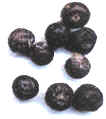Juniper Berries
Information about Juniper Berries plus Juniper Berry Recipe Collection
Â
Â
Â
 Juniper
berries (Juniperus communis L.)
belong to the plant family Cupressaceae (cupress family). Classed
as a shrub, the plant grows to 4 to 6 feet high.Â
The berries are used for the production of the volatile oil which is a prime
ingredient in Gin. In fact, the name �juniper� derives from the French
'genievre,' which means gin. It is one
of the few examples of spices from a cold climatic region. Juniper
berries (Juniperus communis L.)
belong to the plant family Cupressaceae (cupress family). Classed
as a shrub, the plant grows to 4 to 6 feet high.Â
The berries are used for the production of the volatile oil which is a prime
ingredient in Gin. In fact, the name �juniper� derives from the French
'genievre,' which means gin. It is one
of the few examples of spices from a cold climatic region.
Â
Â
Â
Origin
and History of Juniper Berries
Â
The
plant is widely distributed
throughout the Northern Hemisphere in particularÂ
in Europe and Asia and grows prolifically in the wild.
Â
Juniper
has been used for medicinal purposes as far back as 1550BC. A papyrus from
ancient Egypt was discovered which showed Juniper berries as an ingredient
for a medicine to treat tape worms. It is perhaps because of their medicinal
qualities that they were initially incorporated into cooking.
Â
During
the Roman Empire, the dried berries replaced pepper, which was not only scarce
but also expensive and they were used to flavour sheep and game as well as
in sauces.Â
Â
During
the Renaissance c14th Century, their popularity grew probably to
counteract the rich, spicy foods which were being consumed at that time,as
juniper berries aid digestion and it is thought that this same reason
probably accounts for the making of Gin which was first distilled in Holland in the
17th Century.
Â
Â
Cultivation
and Processing of Juniper Berries
Â
 Juniper
berries take two or three years to ripen, so blue and green berries are often
seen together on the same plant. Only the blue, ripe berries are picked. Many of
the crops are harvested from the wild in Europe where the berries are gathered
in the autumn by laying a sheet under the bush and then beating it. Once
collected, they are laid out to dry a little, during which process they lose
some of the blue bloom and develop the blackish colour seen in commerce. Juniper
berries take two or three years to ripen, so blue and green berries are often
seen together on the same plant. Only the blue, ripe berries are picked. Many of
the crops are harvested from the wild in Europe where the berries are gathered
in the autumn by laying a sheet under the bush and then beating it. Once
collected, they are laid out to dry a little, during which process they lose
some of the blue bloom and develop the blackish colour seen in commerce.Â
Â
It
is possible to grow Juniper plants either from seed or by taking cuttings. Seeds
should be sown in a cold frame in spring and planted out in their permanent
position one year later. Stem cuttings should be taken in early autumn and
potted in a sandy soil under glass. Male and female plants are needed for
berries to be produced.
Â
Â
Juniper
Berries in Cooking
Â
Juniper
Berries have a bitter-sweet taste and aroma which goes particularly well with
stronger meats and game. Having said that, if used with discretion, it also
compliments chicken, pork and certain fish such as Salmon.Â
Â
Popular
in some European cuisines, they are excellent when used in marinades,Â
stuffings and p�t�s and are also particularly good with cabbage. They are a
traditional ingredient in German Sauerkraut.
Â
Store
them in an airtight container in a dry, cool place, away from direct
sunlight and lightly crush just before using to release their flavour.
Â
IMPORTANT:Â
Amongst
its many medicinal uses, Juniper is used as a diuretic and also as a
uterine stimulant during labour to improve contractions. It should therefore be
avoided during pregnancy and should not be used when breastfeeding. Do not
give to children under 12 years or the elderly, or to people with kidney
disease.Â
Â
Â
CLICK HERE
FOR LOTS OF RECIPES USING JUNIPER BERRIES
Â
Â
|